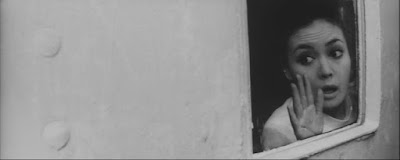In the late 60s Japan’s Shochiku studio made a short-lived and tentative attempt to break into the booming market for science fiction, horror and monster movies. Criterion’s Eclipse Series 37 DVD boxed set When Horror Came to Shochiku includes four of the movies made at Shochiku at that time. When Horror Came to Shochiku is a cool name for a boxed set but a bit misleading since these movies are not quite what one would think as typical late 60s horror films.
The Living Skeleton (Kyûketsu dokuro-sen), made in 1968, is one of these four movies.
You have to bear in mind that this is not a low-budget independent film. It was made by a major studio, with the resources of a major studio. It was made by people who had learnt their craft in a studio system. They were professionals. They knew how to make movies. It has a certain amount of major studio polish.
The Living Skeleton opens in fairly spectacular style. A freighter, the Dragon King, has been captured by pirates. The setting is contemporary - it’s worth remembering that piracy still goes on today. These pirates are particularly ruthless and the crew and the handful of passengers are massacred.
Three years later we meet a young woman named Saeko (Kikko Matsuoka). She lives in a small Japanese costal town. She is an orphan and along with her identical twin sister Yoriko was more or less raised by the village priest. He’s a Catholic priest - Japan has a large Catholic community.
Saeko is a nice girl but she has been troubled since her twin sister disappeared. The sister is assumed to have been drowned when the freighter on which she was travelling went down in a typhoon. Of course the audience knows that the twin sister was killed by those pirates.
Saeko has a boyfriend, Mochizuki (Yasunori Irikawa). He’s a decent guy and they plan to get married.
They go scuba diving and see something unexpected - skeletons.
Later they see a ship. Not on the bottom of the sea, but afloat. Maybe it’s the ship on which Yoriko met her fate. Saeko wants to reach the ship, she does so, and she is disturbed by what she finds.
Then things get spooky for a bunch of people all of whom have something to hide. What they have to hide is connected with the events on board the Dragon King.
Viewers will have their suspicions about what is going on but it may not be so simple.
This is one of those movies that plays around with genre. You think you know what kind of movie it is and then you start to think it’s not that sort of movie at all. And then you find yourself thinking it could belong to any one of several genres. Is anything supernatural going on? Certainly strange creepy things happen. We’re kept guessing. Maybe we’ll get a definite answer at the end. You’ll have to watch the movie yourself to find out.
There are some nicely crazy plot twists.
There’s a touch of ambiguity to at least one major character. We might understand a character’s motivations without entirely approving of the actions to which those motivations lead.
We have to talk about the special effects. There are some very obvious miniatures shots. I don’t mind that. In fact in a movie such as this where you’re not always entirely certainly that everything you see is real or truthful obvious special effects can be an asset. There are some really ambitious effects shots and they’re often quite effective and disturbing.
This film was shot in the ’scope aspect ratio in black-and-white, a combination I always find rather appealing. The cinematography is suitably moody.
This movie has a lot of the qualities you expect in a horror exploitation movie combined with some genuinely unsettling atmosphere. It has some outlandish moments and a few crazy moments.
Overall The Living Skeleton is entertaining with enough weird touches to make it a cut above average. Highly recommended.
The DVD transfer is very good. So far I’ve watched three of the movies in the boxed set. The X from Outer Space (1967) is goofy fun while Goke, Body Snatcher from Hell (1968) is delightfully demented.





2 comments:
I'm going to have to find this box-set - I know I've seen The X From Outer Space, but this one sounds fun!
tom j jones said...
I'm going to have to find this box-set
The boxed set is an absolute must-buy.
Post a Comment